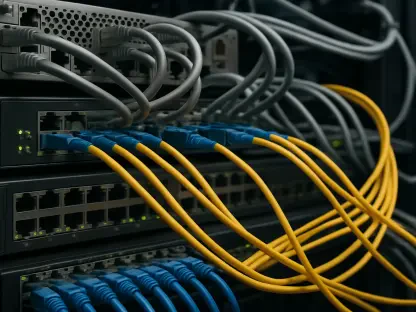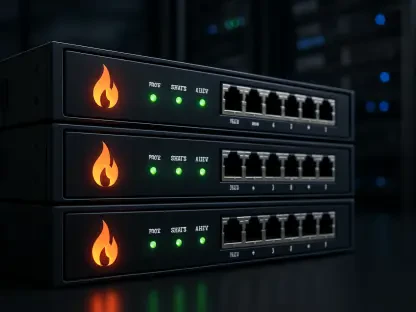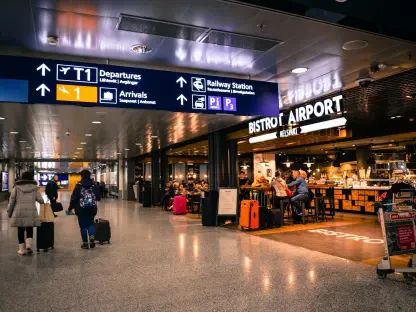The landscape of networking is undergoing a significant transformation as artificial intelligence (AI) continues to expand its footprint across industries. Cisco Systems Inc., long regarded as a leader in networking technologies, is actively reshaping its infrastructure to support the burgeoning needs of AI workloads. In a decisive move divulged during its Cisco Live event, the company has introduced a series of innovations aimed at simplifying network operations, boosting visibility, and integrating AI-efficient methodologies across its products. This strategic shift is designed to address the increasing complexity and demands that accompany AI, enabling businesses to optimize their operations without the need for entirely new systems.
Cisco’s Evolving Network Infrastructure
Data Center Innovations: Redefining Network Performance
Cisco’s advancements in data center technology are pivotal to its strategy for enhancing AI compatibility. At the heart of these developments is the Nexus network switching portfolio, which introduces a “Unified Fabric Experience.” This innovation unifies Cisco’s Application Centric Infrastructure (ACI) and NX-OS VXLAN EVPN fabrics, creating a cohesive control and management layer. ACI’s software-defined networking architecture serves to automate and streamline network configuration according to application demands, significantly improving adaptability and efficiency.
The integration of VXLAN EVPN offers additional layers of flexibility by providing virtual overlays that support Layer 2 traffic over routed networks. Central to this is the enhanced Nexus Dashboard, which acts as a consolidated interface overseeing LAN, storage-area networking, IP fabric management, and AI fabric monitoring. These advances allow for streamlined network management, with an emphasis on managing AI workloads more effectively. The goal is not only to enhance operational efficiency but also to ensure networks remain agile and capable of supporting future demands.
Cisco’s Intelligent Packet Flow emerges as a telemetry-based solution that dynamically routes traffic across AI networks, optimizing performance based on real-time congestion data. This tool enhances diagnostic capabilities and minimizes disruptions by providing unparalleled visibility from network layers to distributed AI jobs. Such innovations are a testament to Cisco’s dedication to creating a robust infrastructure that seamlessly integrates into existing systems, maximizing both performance and reliability.
The Hardware Revolution: Building AI-Optimized Solutions
Hardware innovations play a crucial role in Cisco’s quest to revolutionize networks for AI workloads. AI PODs are at the forefront of this initiative, offering pre-validated infrastructure packages that simplify AI workload deployment. In collaboration with Nvidia Corp., Cisco incorporates Nvidia RTX 6000 Pro GPU into its UCS C845A M8 AI servers, creating a robust “Secure AI Factory” solution. This collaboration illustrates a commitment to maximizing performance and efficiency, ensuring that AI workloads are processed with speed and accuracy.
The introduction of 400G bidirectional optics signifies a substantial leap forward in data transmission capabilities. These optics are designed to support legacy multi-mode fiber infrastructures, enabling upgrades to 400G speeds without the need for entirely new infrastructure. Furthermore, the deployment of smart switches and secure routers, powered by Cisco’s Silicon One chips, offers impressive throughput and reduced latency, alongside advanced security features like post-quantum encryption.
Cisco’s advancements extend to wireless networks, with the introduction of Wireless 9179F access points tailored for high-demand environments. Coupled with the Campus Gateway feature that facilitates seamless roaming, these innovations underscore a commitment to delivering comprehensive solutions across varied environments. Ruggedized switches provide the versatility needed for industrial applications, including autonomous robotic systems, while access points incorporating Wi-Fi offer the reliability needed for operations demanding wireless backhaul.
Integrative Tools and Solutions
Bridging Network and Security Teams: Innovations in Collaboration
One of the core tenets of Cisco’s approach to revolutionizing AI workloads is the integration of network and security functionalities. This strategic alignment is exemplified by Cisco AI Canvas, a real-time collaboration tool designed to integrate network and security teams through a shared user interface. As AI workloads become more prevalent, the need for seamless interaction between network management and security protocols grows increasingly important, a gap that Cisco AI Canvas aims to bridge.
Cisco AI Assistant represents another key advancement, offering natural language task automation trained on a comprehensive library of Cisco documentation. This feature is woven into the fabric of various Cisco platforms, including the Nexus Dashboard, enabling an intuitive, text-first interaction model. As networks become more agentic, this evolution emphasizes infrastructure managed by digital agents, fostering a proactive and preventative approach to network management.
The launch of Cloud Control, presently in preview, showcases a unified management platform encompassing Cisco’s networking, security, and observability tools. This platform is designed with native support for Cisco AI functionalities, allowing for streamlined management and enhanced operational clarity. The introduction of the Room Vision PTZ Camera exemplifies AI-enhanced video conferencing solutions, demonstrating Cisco’s commitment to simplifying setup complexity while maintaining high standards of performance and reliability.
Addressing Rising Security Needs: Enhanced Protection Mechanisms
As digital landscapes continue to evolve with AI, Cisco recognizes the increasing security threats springing from distributed workforces and autonomous AI models. New firewall models and network access offerings, including the Hybrid Mesh Firewall and zero-trust network access, embody Cisco’s defensive advancements. These solutions are tailored to mitigate risks, incorporating a Mesh Policy Engine that simplifies policy applications across heterogeneous infrastructures.
Efforts to fortify Cisco’s security suite are further exemplified by integrations with Cisco’s Secure Access platform, ensuring network-wide policy enforcement and enhancing security consistency. Universal zero-trust network access (ZTNA) solutions now include passwordless authentication features, reinforcing the shift towards a more secure, user-friendly experience. A layered approach to protection also permeates Cisco’s suite of tools securing data in transit, complemented by endpoint security enhancements.
Emphasizing observability, Cisco’s deeper integration with Splunk facilitates better performance tracking and quicker issue resolution. ThousandEyes assurance extensions, aimed at mobile devices, highlight Cisco’s commitment to scalable network monitoring, underscoring the necessity of comprehensive digital observability in AI-driven environments.
Adapting to Changing Demands
Agile Services Networking: Responding to AI Workloads
Cisco’s response to the shifting demands of the service provider segment is encapsulated in its Agile Services Networking architecture. This framework supports diverse traffic types and enables service monetization opportunities, crucial for embracing the new wave of AI-generated network demands. The introduction of converged access and edge routers within this architecture meets performance requirements with resilience, bolstered by satellite integration to serve remote and underserved areas.
As AI workloads continue to shape industries, Cisco’s architecture presents a unified solution, bridging the gap between legacy systems and the next generation of networking needs. By enabling service providers to accommodate a wider range of AI-driven services, Cisco positions itself as a pivotal player in the rapidly evolving telecommunications landscape, taking proactive steps to ensure future-ready solutions that cater to diverse needs.
Satellite integration enhances this architecture by providing resilience and reliability, ensuring seamless connectivity even in traditionally challenging environments. This capability is vital as industries look toward expanding their reach and enhancing connectivity in previously untapped regions. Cisco’s concerted efforts to integrate these advanced capabilities into its architecture promise opportunities for growth and innovation across sectors, ensuring that no area is left behind in the digital revolution.
Innovating for a Connected Future
Cisco’s strategic initiative to revolutionize networks for AI workloads extends beyond hardware and software solutions, encompassing a holistic approach that embraces innovation across the board. By embedding AI-driven functionalities into its products, Cisco not only enhances operational efficiency but also prepares for the eventual integration of autonomous systems within networks. As systems become more agentic, Cisco’s foresight in developing solutions like AI Canvas and AI Assistant highlights a commitment to evolving alongside digital ecosystems.
The convergence of AI and networking necessitates an infrastructure that can dynamically adjust to emerging technologies and security landscapes. Cisco’s comprehensive updates reflect this necessity, showcasing a fusion of networking and security capabilities that cater to contemporary and future needs. By focusing on an integrative approach, Cisco leads the charge in redefining what it means to operate within a connected world, delivering solutions that are both groundbreaking and sustainable.
The trajectory set by Cisco highlights a future where AI and networking operate in unison, driven by technologies that are as innovative as they are reliable. Through this lens, Cisco’s comprehensive advancements pave the way for a seamless transition into an era where AI facilitates every aspect of networking, ensuring businesses remain agile and capable of meeting the challenges of tomorrow.
This holistic approach signifies a future-ready infrastructure, enabling businesses to navigate the complexities of a connected world while capitalizing on the opportunities presented by AI-driven workloads.
Future Considerations and Insights
The realm of networking is experiencing a noteworthy transformation as artificial intelligence (AI) increasingly permeates various sectors. Cisco Systems Inc., a longstanding frontrunner in networking technologies, is proactively revamping its infrastructure to better cater to the surging demands of AI workloads. In a strategic announcement at its Cisco Live event, the company unveiled a set of innovations intended to simplify network operations, enhance visibility, and integrate AI-optimized methodologies into its products. This forward-looking strategy aims to tackle the growing complexity and demands posed by AI, allowing businesses to enhance their operations without the necessity of overhauling their existing systems.
As AI continues to evolve, so do the challenges associated with managing network systems capable of supporting AI applications. Cisco’s approach focuses on infusing AI capabilities across its product line, making it easier for enterprises to adapt to the technological advancements without the need for a complete system redesign. By embedding AI into network management, Cisco seeks to offer effortless scalability, sharpened insight into network performance, and more effective resource allocation. Their innovative solutions will help businesses navigate the intricate landscape of AI-driven operations efficiently.









